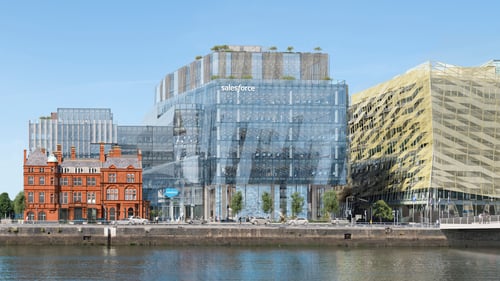How can you implement a successful hybrid work environment? And what can we learn from some of the great multinational companies that have embraced hybrid working? Get a glimpse into how different companies have handled the task, and how they have succeeded with different types of hybrid work models.
By looking into different hybrid work model policy examples you will get inspiration to how others have managed the transition. It is possible for you to pick and choose from the good ideas that can help you create a hybrid work plan that matches your organization. So, if you are also curious about what a hybrid working environment can look like and how it is implemented elsewhere, keep reading. And if you are still not sure why you should want to change to a new model – read here All there is to know about hybrid working (The extensive guide).
Go hybrid with these six hybrid work examples
Let's Visit: Target

A business that has flourished during Corona is the retailer Target. So, their decision to downscale office space is not due to financial issues. In fact, the latest news states that Target hit a sales growth exceeding $15 billion in 2020, and is planning to open 30-40 new stores as well as renovate 150 store locations. Their decision to cut down on real estate office costs is not a way to save rent, but because many of their employees now prefer to work from home they are the first on our list of hybrid work model policy examples.
Therefore, they have left their office building in Minneapolis which represents 1 million square feet, and 3,500 workers. These workers will now go to other nearby office locations if they decide to go to the office. At Target they have seen hybrid working as an opportunity to reduce its real-estate footprint. Target was quite early in making these changes and embracing the hybrid work model where they allow employees to switch between working remotely, at home, or going to the office. Thereby, increasing flexibility in work schedules and reducing commuting problems have been a big concern for many employees.
Let's Visit: Microsoft

One of the major companies that have opted in for a hybrid work environment and has reaped its benefits is Microsoft. It is obvious that a hybrid approach to work is an enormous undertaking for every leader and every organization, and for Microsoft we are talking about an organization that employs more than 160,000 employees across the globe, so it is not a transition done lightly. Either way, they are a great hybrid work example, and as Jared Spataro, Corporate Vice President, Microsoft 365 writes in their blog:
“We’re learning as we go—studying data, listening to our employees, and responding with agility to what works and what doesn’t. Because a growth mindset is the key to charting a path forward in any moment of uncertainty.”
He further states that they have implemented a hybrid work model where ‘work from home’ is accessible for everyone for at least half of the workweek. Furthermore, employees are given the opportunity to prolong that period if it can be agreed upon with the representative manager. They have made a hybrid work policy making it clear to their employees what is allowed. Additionally, they are regularly checking in on the well-being of their employees with surveys empowering managers and leaders to take care of their teams. According to Microsoft, they now have more productive and happier employees by getting rid of this obsolete way of thinking about the work environment. Lastly, they state that being able to hire talent from everywhere has made recruitment much easier.
Let's Visit: Amazon

One of the biggest players on the market, Amazon, have continuously stated that they prefer an ‘office-centric’ model. However, during the pandemic Amazon decided to give employees two days a week where they were allowed to work from home. In this case, we are talking about a company that did not want to embrace hybrid working prior to Covid but found that it was hard to go back afterward. However, they still firmly believe that creativity is something that happens when people are together at the office and that employees invent best if they are together at the office, so everyone is strongly encouraged to go. Also, some work functions such as hardware engineers and frontline operations are required to work at the office.
Nevertheless, they do acknowledge the desire to work from home and nowadays, it is up to each team lead to decide what works best for their unit. Many are picking e.g. three days a week where the whole team is going to the office and then letting them work remotely for the rest. Furthermore, their hybrid work policy example allows employees to work from home or any other location for up to four weeks yearly. It is also possible to apply for being considered ‘a remote worker’ if you want to work from home permanently. In that case, the employee will not have an assigned office space anymore but an agile one. So, this is a good example of how every company is learning as we go, and we should remember that every one of us has been managing every step of the pandemic for the first time.
Let's Visit: Goodyear

The next hybrid work example is Goodyear. You could say that the manufacturing company Goodyear was quick to adopt some hybrid work initiatives. Just before Corona hit, they introduced a new office environment with collaboration spaces being the heart of the office. However, the latest news also positions the company as an example of a business being reluctant to the hybrid work transition. Nevertheless, the pandemic made them realize that rules have been changing and that they need to make hybrid work accessible for all employees by having technology foster projects and training. So, in order to move forward Goodyear embraced new technologies, which became a game changer for their inclusion of every worker in their hybrid work model.
Previously being an engineer meant always having to be present where the problem was and having to go to the factory to provide support. However, when countries shut down, they had to be innovative and find a solution. They started to provide engineers with a remote video connection. For Goodyear, it means that they can now quickly put eyes on a problem, rather than having to fly people around the country or the world when there is an issue. Now they can simply have a remote video collaboration.
As Dallas Olson, VP of Global Manufacturing and Engineering, Goodyear states in the news they are not sure that they would have adopted new technologies if the pandemic had not pushed and driven the deployment forward. And, moving away from traditional ways of doing it is always difficult also for the staff included. But seeing as teams can now resolve issues faster the benefits are now coming into the light. Generally, support functions and training have in many situations moved online now.
So, even industrial companies can thrive with all kinds of workers working from home. In Goodyear, all employees can now work remotely depending on circumstances. But generally, many employees now come to the office just a couple of days of the week and are all offered a hybrid work solution.
Let's Visit: Salesforce

At Salesforce, they have truly adopted hybrid working even pre covid, because they had noticed the need for flexible work schedules to improve work-life balance. They are a proven good hybrid work example, as had staff working from home two days a week on average and remote work had already proved to be working for some teams without hurting productivity. However, they still find that in-person interactions are invaluable for collaboration and morale but find that it no longer makes sense to mandate where and when people work.
Salesforce has embraced a model they call ‘Success from anywhere’ which has proven to be very successful for them, as employee surveys show that employees are 16% more likely to agree that they are more productive at home than in the office. The office remains a hub for meaningful collaboration, so they have redesigned the office to have 64% more group spacing and try to schedule only what they call ‘smart’ meeting where only the ones that need to b there is present and ensuring a meaningful agenda. They also moved training programs online to make them more accessible for everyone. However, they only allow fully vaccinated people to come to the office and mandate onsite covid-19 testing, while the rest must stay fully remote.
Let's Visit: AskCody
At AskCody we have always felt the importance of sharing learnings with each other. As Allan Mørch, CEO & Founder of AskCody states, we have been working flexibly for years.
“We have always embraced working distributed and used technology to support and empower us in work”
The majority of tasks are possible to do from home, and with the right tools employees can be productive. However, different situations call for different workstyles. On one hand, when you need time for focus work and to prioritize getting tasks done, many do it best from home. On the other hand, when you need to socialize and get creative, many go to the office where they are then more open for engagement and like being ‘disturbed’ by coworkers.
We try to still maintain a company culture by arranging lunch 2 days a week, yoga sessions, and organizing mandatory events once in a while to get people together, however in the everyday workweek we trust people to find their best balance between working from home, remote, distributed, or at the office.
We find that it is important to build a foundation with a well-trained management team that cares about the well-being of their employees. When encouraging employees to manage their schedules themselves, we are giving them higher job satisfaction and fostering inclusivity.
- Allan Mørch, CEO & Founder, AskCody“Work is not a place you go - it’s something you do.”
We hope the different hybrid work model policy examples gave you the inspiration to create your own. If so we recommend reading more about how to implement a hybrid work policy.



